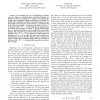28 search results - page 3 / 6 » Degrees of Freedom of Cooperative MIMO in Cellular Networks |
VTC
2007
IEEE
13 years 11 months ago
2007
IEEE
Abstract—Among radio technologies, multiple-input multipleoutput (MIMO) systems have attracted wide research interests in recent years. It is widely recognized that MIMO systems ...
GLOBECOM
2008
IEEE
13 years 11 months ago
2008
IEEE
— In this paper, we propose a novel asynchronous Media Access Control (MAC) protocol, Opportunistic MAC (OMAC), for Multiple Input Multiple Output (MIMO) ad-hoc networks. The pro...
GLOBECOM
2009
IEEE
13 years 2 months ago
2009
IEEE
Today, it is well understood that interference poses the main capacity limitation and thus challenge for future cellular networks. A promising concept that addresses interference i...
TCOM
2010
13 years 3 months ago
2010
—In a wireless network, the use of cooperation among nodes can significantly improve capacity and robustness to fading. Node cooperation can take many forms, including relaying ...
CORR
2010
Springer
13 years 4 months ago
2010
Springer
We investigate the role of cooperation in wireless networks subject to a spatial degrees of freedom limitation. To address the worst case scenario, we consider a free-space lineof-...

